| Author |
Message |
Aed Thompson

Location: Staffordshire, UK Joined: 04 Nov 2011
Posts: 26
|
 Posted: Sat 30 Jun, 2012 6:29 pm Post subject: Sli■rung - Migration period Sword Posted: Sat 30 Jun, 2012 6:29 pm Post subject: Sli■rung - Migration period Sword |
 |
|
This is my first sword project, inspired by the Staffordshire Hoard, but also the pommel-cap of H÷g-Edsten, west Sweden.
The blade is by Paul Binns, and a little on the short side (around 27 inches) but was affordable for this reason. The decorative collars and rings based on K1613 and k470 respectively, the rivet-heads and the pommel-cap were produced by George Easton (danegeld.co.uk). The guards, grip and sheath were produced and assembled by myself.
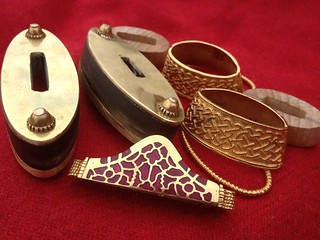 .......... ..........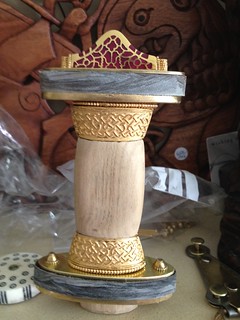
The pommel-cap is dated to around the late 6th Century, while the filigree elements while the Hoard filigree pieces could be from late 6th to early 8th. The closest parallel outside the hoard is the Market-Rasen hilt dated to the early 7th.
Though this is ostensibly a Hoard-inspired sword we chose to include the H÷g-Edsten pommel-cap to allow comparisons to be made between it and our other hoard pieces, particularly k711.
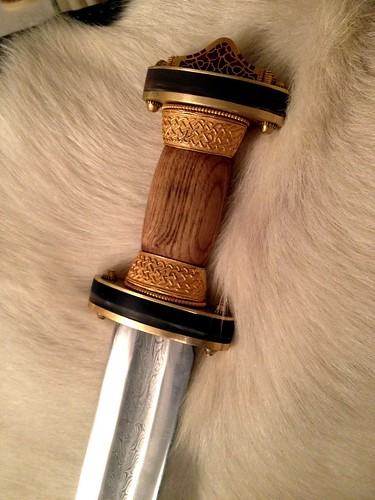 ......... .........
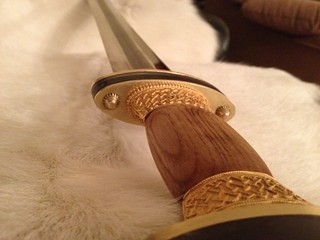 ............ ............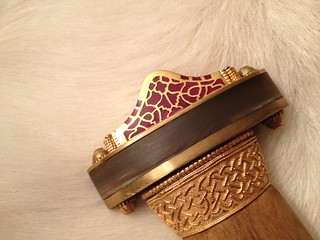
 .... ....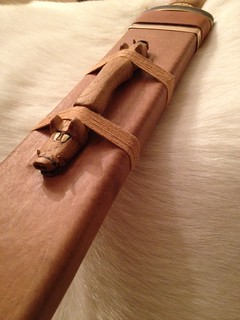 ..... .....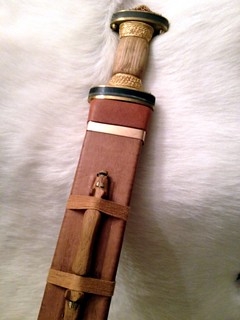
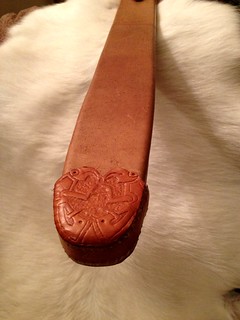 .......... ..........
I've been putting off posting this until I was completely happy with the sheath, but I've somewhat hit a wall with it. If anyone has any constructive criticism or advice with respect to tastefully improving the sheath I would be grateful for any input.
Aed Thompson
Thegns of Mercia
|
|
   |
 |
Cole B

|
 Posted: Sat 30 Jun, 2012 7:03 pm Post subject: Posted: Sat 30 Jun, 2012 7:03 pm Post subject: |
 |
|
Wow, very nice. Don't stress about the length - it's how you use it.
If I had to suggest something for the scabbard, I would say the 'weak' point is the rather plain body. Perhaps something to break up the uniform color, like distressing the leather, embossing, or risers.
|
|
  |
 |
Jim Adelsen
Industry Professional

|
 Posted: Sat 30 Jun, 2012 7:05 pm Post subject: Posted: Sat 30 Jun, 2012 7:05 pm Post subject: |
 |
|
That is a great looking sword. I would really like a migration sword like that myself one day. Beautiful.
www.viking-shield.com
|
|
   |
 |
|
Robert Muse
|
 Posted: Sat 30 Jun, 2012 8:30 pm Post subject: Posted: Sat 30 Jun, 2012 8:30 pm Post subject: |
 |
|
A really beautiful job on the sword! Wish it were mine!!! The only comments I would make about the scabbard is that it doesn't seem to reflect the same status as the sword. A bit of brass maybe?
Regards
Robert
|
|
  |
 |
|
Stephen Curtin
|
 Posted: Sun 01 Jul, 2012 2:03 am Post subject: Posted: Sun 01 Jul, 2012 2:03 am Post subject: |
 |
|
Hi Aed, unfortunately I can't really add any constructive advice as regards the scabbard, so all I will say is that's a very fine piece you have there.
╔irinn go Brßch
|
|
   |
 |
|
K J Seago
|
 Posted: Mon 02 Jul, 2012 2:43 am Post subject: Posted: Mon 02 Jul, 2012 2:43 am Post subject: |
 |
|
lovely stuff, i must agree, maybe a bit more decoration along the scabbard.
just another student of an interesting subject, 
|
|
  |
 |
Matthew Bunker

Location: Somerset UK Joined: 02 Apr 2009
Posts: 483
|
 Posted: Mon 02 Jul, 2012 3:16 am Post subject: Posted: Mon 02 Jul, 2012 3:16 am Post subject: |
 |
|
Lovely hilt fittings, works very well together to make for a really nice sword. I think the scabbard needs to do it justice. So.......
Firstly, you need to change the overall profile, as the section should be an elipse, not a rectangle. At the moment it lacks elegance, looks too blocky. this will mean stripping the leather from it and starting again, possibly making a new core from scratch, depending on the method that you used.
Then, before applying the leather, you might want to create some raised decration using cordwork. The majority of early English scabbard remains that feature decoration have simple cordwork designs, either a central line running from top to bottom or with the addition of two shorter cords radiating out from the central one. Normally it doesn't get any more complex than this but there is one period scabbard from Lapwin Hill with the whole of the front decorated with a lozange/interlace design, executed in cordwork.
If you want to keep it English examples, that's pretty much it but if you're happy to include Scandinavian elements then there are further options featuring both raised decoration and carving.
I'd ditch the slide I'm afraid, lovely work though it is.
All remains of organic slides from England (which you can count on one hand) seem to have been plain, with either splayed or rounded ends, bound under linen braids/tapes at both ends (which not only adds security but also decoration) rather than being lashed down by cord/thing; that binding method seems to be more appropriate for a 2nd-4th century fitting.
Copper alloy mouthpieces, with lateral multiple ridges are common finds for English scabbards of this period. Some are soldered closed, some (presumably ones that have been reused) are just rivetted at the back.
Copper alloy edge strips are another common feature, which probably dictate the suspension method (which can, but doesn't have to, involve buttons, pyramids etc).
I really like the leather chape. Nice work there.
I'm sure you know where to find the on-line examples of my work of this type, so there's no need for me to advertise it here.
I'm happy to give you more help/advise with this if you'd like to discuss it further, seeing as we've met. 
"If a Greek can do it, two Englishman certainly can !"
|
|
  |
 |
Paul Mortimer

|
 Posted: Mon 02 Jul, 2012 12:09 pm Post subject: Posted: Mon 02 Jul, 2012 12:09 pm Post subject: |
 |
|
Great work Aed. Love the chape, too. Also agree with Matt's comments.
Paul
|
|
   |
 |
Aed Thompson

Location: Staffordshire, UK Joined: 04 Nov 2011
Posts: 26
|
 Posted: Mon 02 Jul, 2012 5:16 pm Post subject: Posted: Mon 02 Jul, 2012 5:16 pm Post subject: |
 |
|
Thanks very much for everyone's positive comments, and particularly Matt for his advice.
I agree the sheath so far isn't adequate. My initial plan was to put together something entirely organic and fairly basic to contrast with the v7-inspired sheath of my dad's, and the Chessel-Down throat replica on our other decent sword. However the hilt turned out rather more splendid than I had planned for, and I've been struggling to get the sheath to be visually compatible with it, working within the existing plan. In general, I think more metallic decoration is the way to go.
I did try linen tapes to secure the scabbard slide, but not only was it rather messy but it did not look at all right for this sheath; I think the rectangle cross section may be the problem here. The tapes overlapped by tight linen cord were not sufficient to secure the scabbard slide, partly because the shape of the slide is not suited to being secured in this way, and partly, I think, because the corners of the sheath prevent the tension from being distributed evenly as it would on a sheath that has an elliptical cross-section. It is currently secured with linen cord.
With respect to cord-work beneath the leather, it's not clear on the photographs but we did do a tiny bit of it on this sheath; 2cm pieces of leather cord were glued in position either side of where the boar-heads of the scabbard-slide would sit before applying the leather, to reduce lateral slipping. This was our first attempt and went well enough that I'm confident we can try something more ambitious with this technique now.
The leather can be recycled but I think the sheath core will probably need remaking. It is, at least, an opportunity for me to try and tackle the interference between the top of the sheath and the lower-lower rivet heads that we, for the time being, had to solve by adding a mobile leather throat to cup round them.
I remain rather attached to the brass and carved oak boar-headed scabbard-slide. I may be making another children's sword at some point, so I'll put it on the sheath of that. The chape will only work on a rectangular cross-section sheath so will have to go. -I still have the sketches though, so this could potentially be re-done.
A pair of scabbard-bosses would certainly help raise the sheath to the status of the sword, but the STH pair are already in use and I prefer not to use Sutton Hoo material outside of its proper context. That leaves only the Griston find. They make a big difference visually, either side of a scabbard slide, and I'll have to have a think about what I can use instead.
Plenty of pyramids around but my own feeling is that these fit better on peacebands than straps. What colour peacebands is a whole 'nother headache.
I'll have to look into Lapwing Hill; it looks difficult, but being a Mercian find is a bonus. Its working out the design above the leather that's going to bug me.
Aed Thompson
Thegns of Mercia
|
|
   |
 |
Matthew Bunker

Location: Somerset UK Joined: 02 Apr 2009
Posts: 483
|
 Posted: Tue 03 Jul, 2012 1:42 am Post subject: Posted: Tue 03 Jul, 2012 1:42 am Post subject: |
 |
|
| Aed Thompson wrote: |
I'll have to look into Lapwing Hill; it looks difficult, but being a Mercian find is a bonus. Its working out the design above the leather that's going to bug me. |
Lapwing Hill looks difficult but it really isn't. It's a simple repeating design that's easy to draw out on the wood core. Then apply glue and lay the cord down....5 straight lengths and then 8 wavey lengths in pairs which touch to give the impression of interlace. Use good quality veg tan, 1mm-1.5mm ideally (Hoopers in Walsall used to be the best place for leather in the West Midlands but I don't know if they're still there) and, once you've sewn it up, case the front in small sections and work it down with a smooth antler point or bone creaser. Stain it whith whatever you fancy, rub an oil/wax or lard mix into it and buff the hell out of it. Not difficult, just time consuming. The real key is making sure that the leather is a good, tight fit to the scabbard before you start working it down into the cordwork. If you need any help or advise, let me know.
If you don't want to go with bosses or pyramids then using metal edge strips and a two piece belt is a visually interesting alternative. You could even do away with a slider/bridge using that method, if you wanted to, in the Brighthampton style.
I disagree on pyramids being restricted to peace ties, continental evidence points to them having a wider role to play in suspension systems. The fact they're often found singly, outside of a burial context is a good sign that they were employed as decoration rather than as part of a load bearing assembly but I don't think it's safe to say that their use was limited to this. However, that's just opinion.
BTW, I know the secret of making your line tape bindings secure. So far I've only shared it with Mr Mortimer though.
"If a Greek can do it, two Englishman certainly can !"
|
|
  |
 |
|
Bruce Tordoff
Industry Professional
|
 Posted: Tue 03 Jul, 2012 11:41 am Post subject: staffs hoard sword Posted: Tue 03 Jul, 2012 11:41 am Post subject: staffs hoard sword |
 |
|
Congrats to George on his execution of the Swedish Pommel and Staffs collars, all in all, goes well together, with Binnsy's fine blade.
However I do have a criticism, which is purely aesthetic, I Think the collars give an adequate clue as to the overall intended shape of the grip including the organic part. ie, the grip would look better 'waisted' or concave. I feel that the Wooden part makes the overall effect look bloated and ungainly. I have handled swords with Convex grips on single handed hilts and they are definately not as comfortable and 'planted' as a concave grip, where the hand naturally falls into the dips in the grip, giving a feeling of security and greater control and comfort.
See my edited version of your hilt for a better visual explanation,
So get busy with the file and it'll be finished.
only kidding, if you have hands like Meadowlark Lemon, (Before your time!) then I suppose you might find it comfy.
That's the good thing, one can introduce a modicum of personal preference.
Please don't take this as negative though.
Bruce
 Attachment: 178.29 KB Attachment: 178.29 KB
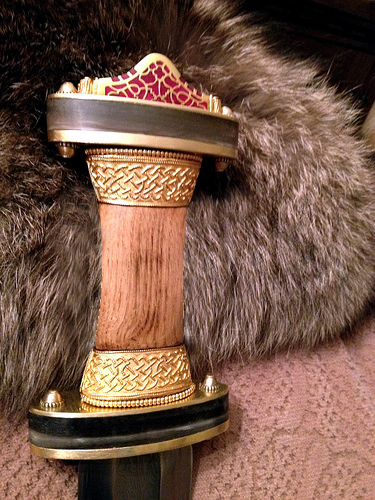
|
|
  |
 |
Aed Thompson

Location: Staffordshire, UK Joined: 04 Nov 2011
Posts: 26
|
 Posted: Fri 06 Jul, 2012 3:24 am Post subject: Posted: Fri 06 Jul, 2012 3:24 am Post subject: |
 |
|
Bruce, thanks for the comments on the handle. While I agree that with respect to aesthetics a continuous hourglass handle may be better, and is implied by other collars of this kind, these particular collars have a much broader aperture and shallower slope that makes the handle-shape somewhat more open to interpretation.
I agree that a convex hilt would be uncomfortable to any normal hand on this type of sword, but that is not what we are dealing with here. At its widest point, the wooden section of the hilt still has a smaller diameter than the larger diameter of the filigree collars. Because of this, the handle is in fact widest towards the guards, encouraging the hand toward the middle of the handle. The slight bulge of the wooden section has been shaped to conform to the dip of the palm formed between the finger joints and thenar as the hand is closed.
I feel that in light of the palm-dip, having an entirely concave handle that is narrowest towards the middle would be undesirable, as it is entirely opposite to the anatomy of the palm when the hand is closed. A number of reconstructed swords with concave handles (implied by collars) I have seen are carved to have a bulging nut in the middle of the handle to occupy this gap, which makes ergonomic sense. The handle on mine could be considered as one of these nuts enlarged to occupy the entire palm.
When held, the wooden section's bulge fits the palm perfectly, while the slope of the collars discourages the hand from slipping in the direction of the guards. The index and little fingers then sit in the slight valleys created between the wooden section and the slopes of the lower and upper collars respectively, while the slight bulge of the wooden section also allows the middle and ring fingers to adopt a more natural position curling less tightly than the index and little fingers, just as happens with a relaxed hand.
The result is that when the hand is wrapped around the handle of this sword, the entire hand makes contact with the handle, even when gripped very loosely. The handle conforms to the hand, not vice versa. This is very comfortable, and I think probably gives the illusion that the sword is lighter than it really is.
I think it's an approach that provides an interesting contrast to our other two swords; one which has a smooth flattened cylidrical handle relying on grip-strength for security, and the other which has a non-ergonomic spiral for maximum grip to some degree at the expense of comfort.
Aed Thompson
Thegns of Mercia
|
|
   |
 |
|
Bruce Tordoff
Industry Professional
|
 Posted: Fri 06 Jul, 2012 5:42 am Post subject: new sword Posted: Fri 06 Jul, 2012 5:42 am Post subject: new sword |
 |
|
Hi Aed,
I see you've given this serious consideration. but fair comment.
I know what you mean about the central grip 'nut' does fit in the concave part of the palm.
As I said, a modicum of personal preference and interpretation can be employed in these cases. Indeed, Why should there be a 'standard' grip, when essentially not all hands are identical in size and indeed the person wielding said sword could be of any size and stature.
Oh incidentally, any chance of a pic of the top of the pommel, the H÷g-Edsten has some pretty cloisonne on the top, it would be nice to see that too.
Cheers,
Bruce
|
|
  |
 |
Aed Thompson

Location: Staffordshire, UK Joined: 04 Nov 2011
Posts: 26
|
 Posted: Fri 06 Jul, 2012 7:48 am Post subject: Posted: Fri 06 Jul, 2012 7:48 am Post subject: |
 |
|
Thanks Bruce. I'm afraid I don't have any pics of the top of the pommelcap stored, and I'm currently on a 2-week fieldcourse, but I'll try and get some photos of it uploaded as soon as possible. In the meantime, a better pic of it pre-assembly.

With respect to the sheath, I think our best bet is to remake it with an eliptical cross-section, do some simple lines of cordwork, try a plain slide and the linen wraps again. I've managed to track down a number of more recent scabbard-boss finds lurking in the Portable Antiquities Scheme database, some of which might be exactly what we need, with the addition of some pyramids on the peacebands probably at some point down the line.
If the linen wraps still don't look right, we'll put some more brasswork on it like Brighthampton.
Aed Thompson
Thegns of Mercia
|
|
   |
 |
|
Brian Nelson
Location: Houghton, MI Joined: 17 Mar 2012
Posts: 43
|
 Posted: Thu 26 Jul, 2012 3:09 pm Post subject: Posted: Thu 26 Jul, 2012 3:09 pm Post subject: |
 |
|
|
Looks incredible. Are the metal fittings gilded?
|
|
   |
 |
Phil U

Location: Seattle Joined: 07 Nov 2010
Posts: 44
|
 Posted: Thu 26 Jul, 2012 9:24 pm Post subject: Re: Sli■rung - Migration period Sword Posted: Thu 26 Jul, 2012 9:24 pm Post subject: Re: Sli■rung - Migration period Sword |
 |
|
| Aed Thompson wrote: | | This is my first sword project,. |
Wow! Very well done.
|
|
  |
 |
Aed Thompson

Location: Staffordshire, UK Joined: 04 Nov 2011
Posts: 26
|
 Posted: Fri 27 Jul, 2012 6:57 am Post subject: Posted: Fri 27 Jul, 2012 6:57 am Post subject: |
 |
|
Thanks very much!
The collars, hoops and pommelcap are gilded copper alloy to simulate gold. The scennas are copper-alloy; 2mm for the uppers and 4mm for the lowers to simulate the look of low-purity gold tray-types.
http://3.bp.blogspot.com/-1rKp2f7miAE/T-hJlwu...D+DIAG.JPG
Apologies about getting pics of the top of the pommelcap; been rushed of my feet recently and now in Denmark until next weekend. I'll try and get them ASAP.
Aed Thompson
Thegns of Mercia
|
|
   |
 |
Aed Thompson

Location: Staffordshire, UK Joined: 04 Nov 2011
Posts: 26
|
 Posted: Wed 08 Aug, 2012 3:36 am Post subject: Posted: Wed 08 Aug, 2012 3:36 am Post subject: |
 |
|
Here's the pics of the top of the pommelcap as requested, with a sneaky peak of the new sheath core.


Aed Thompson
Thegns of Mercia
|
|
   |
 |
|
David Clark
|
 Posted: Wed 25 Sep, 2013 12:34 pm Post subject: Posted: Wed 25 Sep, 2013 12:34 pm Post subject: |
 |
|
That is a very handsome sword you have got there. I do wish you had a picture of it full length, unsheathed.
With a 27 inch blade and handle of approx 5 inches, I would guess, your sword is in the 32-36 range?
What is the Point of balance?
|
|
  |
 |
|
|
You cannot post new topics in this forum
You cannot reply to topics in this forum
You cannot edit your posts in this forum
You cannot delete your posts in this forum
You cannot vote in polls in this forum
You cannot attach files in this forum
You can download files in this forum
|
All contents © Copyright 2003-2024 myArmoury.com — All rights reserved
Discussion forums powered by phpBB © The phpBB Group
Switch to the Basic Low-bandwidth Version of the forum
|

